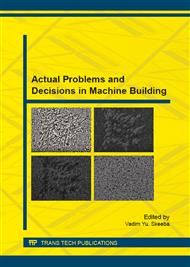[1]
M.M. Matlin, S.L. Lebsky, A.I. Morgunova, Laws of elastoplastic contact problems in surface plastic hardening, Mashinostroyeniye-1, Moscow, 2007. (in Russian).
Google Scholar
[2]
M.M. Zhasimov, Quality control of parts at surface plastic deformation, Nauka, Alma-Ata, 1986. (in Russian).
Google Scholar
[3]
V.M. Smelyanskiy, Hardening mechanics of parts by surface plastic deformation, Mashinostroyeniye, Moscow, 2002. (in Russian).
Google Scholar
[4]
A.S. Donskov, Mathematical modeling of the indentation of a rigid punch in elastic-plastic half-space, Deformation and fracture of materials. 3 (2011) 16-22. (in Russian).
Google Scholar
[5]
P.M. Ogar, V.A. Tarasov, A.A. Daineko, On the issue of the elastic-plastic introduction of a spherical indenter, Systems. Methods. Technologies. 10 (2011) 14-16. (in Russian).
Google Scholar
[6]
P.M. Ogar, V.A. Tarasov, A.V. Turchenko, Effect of the hardenable material characteristics on a spherical asperity elastoplastic indentation, Systems. Methods. Technologies. 11 (2011) 29-34. (in Russian).
Google Scholar
[7]
P.M. Ogar, V.A. Tarasov, A.V. Turchenko, Contact geometry in the process of elastic-plastic indentation of a spherical asperity, Systems. Methods. Technologies. 1 (2012) 9-16. (in Russian).
Google Scholar
[8]
P.M. Ogar, V.A. Tarasov, Kinetic Indentation Application to Determine Contact Characteristics of Sphere and Elastoplastic Half-Space, Advanced Materials Research. 664 (2013) 625-631. (in Russian).
DOI: 10.4028/www.scientific.net/amr.664.625
Google Scholar
[9]
H. Lee, J.H. Lee, G.M. Pharr, A numerical approach to spherical indentation techniques for material property evaluation, J. Mech. Phys. Solids. 53 (2005) 2037-(2069).
DOI: 10.1016/j.jmps.2005.04.007
Google Scholar
[10]
N.K. Myshkin, M.I. Petrokovets, Friction, lubrication, wear. Physical basis and engineering applications of tribology, FIZMATLIT, Moscow, 2007. (in Russian).
Google Scholar
[11]
A.N. Bolotov, V.V. Meshkov, O.V. Sutyagin, M.V. Vasil'yev, The influence of hardening on the characteristics of the surface microasperities elastoplastic contact, Izvestiya Samar. nauch. tsentra RAN. 15 (2013) 313-315. (in Russian).
Google Scholar
[12]
P.M. Ogar, V.A. Tarasov, D.B. Gorohov, A.V. Turchenko, The account of hardening material characteristics in applying of Meyer's empirical law, Systems. Methods. Technologies. 4 (2013) 50-54. (in Russian).
Google Scholar
[13]
M.P. Markovets, Determination of mechanical properties of metals hardness, Mashinostroenie, Moscow, 1979. (in Russian).
Google Scholar
[14]
S.I. Bulychev, V.P. Alekhin, Material Testing by Continuous Indentation of an Indenter, Mashinostroenie, Moscow, 1990. (in Russian).
Google Scholar
[15]
S.I. Bulychev, Transition from indentation diagrams to stress-strain diagrams taking into consideration hardened surface layer, Deformation and fracture of materials. 2 (2010) 43–48. (in Russian).
Google Scholar
[16]
S.I. Bulychev, Hardness and hysteresis at the yield strength, Deformation and fracture of materials. 1 (2011) 41-45. (in Russian).
Google Scholar
[17]
X. Hernot, O. Bartier, Y. Bekouche, R. El Abdi, G. Mauvoisin, Influence of penetration depth and mechanical properties on contact radius determination for spherical indentation, International Journal of Solids and Structures. 43 (2006) 4136-4153.
DOI: 10.1016/j.ijsolstr.2005.06.007
Google Scholar
[18]
J. -M. Collin, G. Mauvoisin, P. Pilvin, Materials characterization by instrumented indentation using two different approaches, Materials and Desing. 31 (2010) 636-640.
DOI: 10.1016/j.matdes.2009.05.043
Google Scholar


